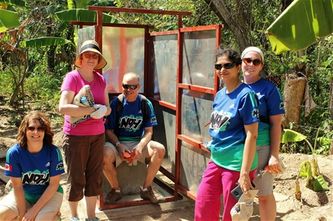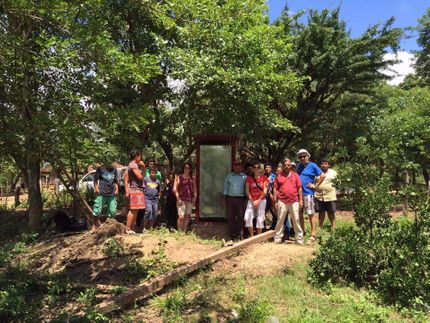NON-PROFIT ORGANIZATION
OUTHOUSES
An outhouse often provides the shelter for a pit latrine, which collects human feces in a hole in the ground. When properly built and maintained they candecrease the spread of disease by reducing the amount of human feces in the environment from open defecation. COMMIT has been happy to provide many villages with proper sanitation.
Key facts
- In 2020, 54% of the global population (4.2 billion people) used a safely managed sanitation service.
- Over 1.7 billion people still do not have basic sanitation services, such as private toilets or latrines.
- Of these, 494 million still defecate in the open, for example in street gutters, behind bushes or into open bodies of water.
- In 2020, 45% of the household wastewater generated globally was discharged without safe treatment.
- At least 10% of the world’s population is thought to consume food irrigated by wastewater.
- Poor sanitation reduces human well-being, social and economic development due to impacts such as anxiety, risk of sexual assault, and lost opportunities for education and work.
- Poor sanitation is linked to transmission of diarrhoeal diseases such as cholera and dysentery, as well as typhoid, intestinal worm infections and polio. It exacerbates stunting and contributes to the spread of antimicrobial resistance.
Overview
Some 829 000 people in low- and middle-income countries die as a result of inadequate water, sanitation, and hygiene each year, representing 60% of total diarrhoeal deaths. Poor sanitation is believed to be the main cause in some 432000 of these deaths and is a major factor in several neglected tropical diseases, including intestinal worms, schistosomiasis, and trachoma. Poor sanitation also contributes to malnutrition.
In 2020, 54% of the global population (4.2 billion people) used a safely managed sanitation service; 34% (2.6 billion people) used private sanitation facilities connected to sewers from which wastewater was treated; 20% (1.6 billion people) used toilets or latrines where excreta were safely disposed of in situ; and 78% of the world’s population (6.1 billion people) used at least a basic sanitation service.
Diarrhoea remains a major killer but is largely preventable. Better water, sanitation, and hygiene could prevent the deaths of 297000 children aged under 5 years each year.
Open defecation perpetuates a vicious cycle of disease and poverty. The countries where open defection is most widespread have the highest number of deaths of children aged under 5 years as well as the highest levels of malnutrition and poverty, and big disparities of wealth.
Benefits of improving sanitation
Benefits of improved sanitation extend well beyond reducing the risk of diarrhoea. These include:
- reducing the spread of intestinal worms, schistosomiasis and trachoma, which are neglected tropical diseases that cause suffering for millions;
- reducing the severity and impact of malnutrition;
- promoting dignity and boosting safety, particularly among women and girls;
- promoting school attendance: girls’ school attendance is particularly boosted by the provision of separate sanitary facilities;
- reducing the spread of antimicrobial resistance;
- potential recovery of water, renewable energy and nutrients from faecal waste; and
- potential to mitigate water scarcity through safe use of wastewater for irrigation especially in areas most affected by climate change.
Sanitation Saves Lives
Poor sanitation practices help many water-borne diseases spread, such as cholera, typhoid fever and malaria. Despite this, many communities have little awareness of this, and knowledge of their connection is still very low in developing countries.
Many people use the same water source that they dump their waste in for cooking, cleaning and drinking. Diarrhea, a very preventable condition, causes a disproportionately high child mortality rate in many countries.
In fact, water-related diseases are responsible for the deaths of more than 5 million people annually, worldwide1. This high mortality rate is largely attributed to how quickly the contamination of water sources can occur and spread throughout communities, especially developing ones.
People in these countries tend to rely on natural sources of water for a living, despite the fact that untreated waste (both human and industrial) might be dumped into the same source upstream. Water’s natural ability todissolve compoundsmeans it is easily polluted by human activities.
Access to improved water supply and sanitation is one of the basic needs and rights of every person. The health of the people and dignified life is ensured through access to improved water supply and basic sanitation. Improved water supply together with proper sanitation increases the health, social, and economic well-being of the people [1]. Ensuring access to improved water supply and basic sanitation services is the first step in eradicating poverty, especially in developing countries
OUTHOUSES FOR San Luis
The village of San Luis received 15 brand new outhouses. Our team put a few of them together which was both challenging and fun. The people of the village had dug the holes and lined them with bricks and motar before we had arrived. This will greatly improve the santitation in the village. Our hope is to raise money to build more outhouses in 2018 for both villages.
This past September Doug Pinder, Doug Thompson, Pam Murrary and Janice Rauser travelled to Nicaragua to distribute the contents of a container of supplies that COMMIT sent. While in Nicaragua they had the honour of delivering the tops and seats for the outhouses to the village of Nandarola. They were thrilled to get 15 new outhouses.



